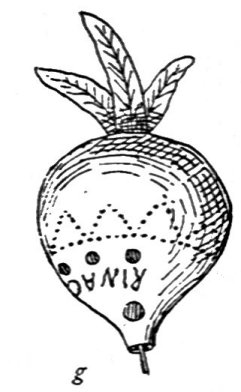The source page number appears in brackets
before the text of the page.
52. Hoo-lei-po-po - CUP AND BALL

[Page 226]A ball (po-po) made of rags of kapa is tied by a cord fastened to the middle of a stick about eight feet long, at the end of which a pocket (pa-ke-ke) is attached. The stick is grasped by the other end, and the object is to swing the ball and catch it in the pocket. Two or more play. When one misses, the next takes a turn. The maximum count is one hundred. There are two specimens in the Berlin Museum, one with a kapa and the other with a cocoanut ball. Another (Plate XIIf) is figured in the Ethnographic Album of the Pacific Islands, where it is described as consisting of a light wand of twisted leaf-ribs with a loop at the end.
Plate XIIg, shows a gourd musical instrument (probably a lover's whistle, i-pu ho-ki-o-ki-o) attached by a string ornamented with tufts of feathers.
 In Captain King's journal of Cook's voyage to the Pacific
ocean,1 he says that young Hawaiian children have a favorite
amusement which shows no small degree of dexterity. They [Page 227] take a short stick,
with a peg, sharpened at both ends, running through one extremity of it and
extending about an inch on each side; and throwing up a ball made of green
leaves molded together, and secured with twine, they catch it on the point of
the peg; and immediately throwing it up again from the peg, they turn the stick
around, and thus keep catching it, on each peg alternately, without missing it,
for a considerable time.
In Captain King's journal of Cook's voyage to the Pacific
ocean,1 he says that young Hawaiian children have a favorite
amusement which shows no small degree of dexterity. They [Page 227] take a short stick,
with a peg, sharpened at both ends, running through one extremity of it and
extending about an inch on each side; and throwing up a ball made of green
leaves molded together, and secured with twine, they catch it on the point of
the peg; and immediately throwing it up again from the peg, they turn the stick
around, and thus keep catching it, on each peg alternately, without missing it,
for a considerable time.
1 Vol. III, p. 147.
Last update February 1, 2010